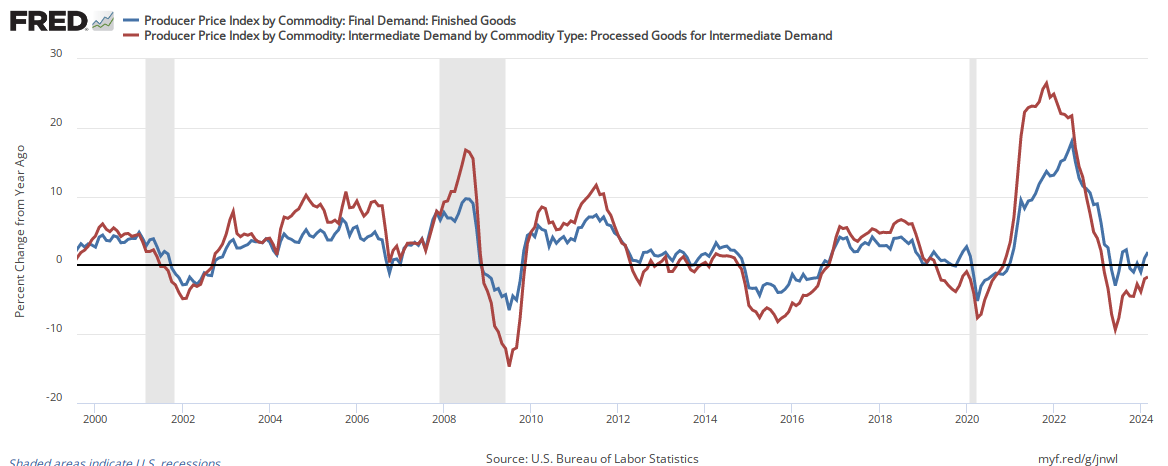December 2018 Producer Price Final Demand Year-Over-Year Inflation Unchanged
The Producer Price Index year-over-year inflation remains at 2.5 %.

Analyst Opinion of Producer Prices
The Producer Price Index was unchanged year-over-year. Energy prices decline was offset by food price increase - and service prices modestly declined. Here is what the BLS said in part:
Final demand goods: The index for final demand goods moved down 0.4 percent in December, the same as in November. In December, the decline was the result of a 5.4-percent drop in the index for final demand energy. In contrast, prices for final demand foods advanced 2.6 percent, and the index for final demand goods less foods and energy rose 0.1 percent.
Product detail: Leading the December decrease in the index for final demand goods, gasoline prices dropped 13.1 percent. The indexes for diesel fuel, basic organic chemicals, jet fuel, residual fuels, and beef and veal also moved down. Conversely, prices for fresh fruits and melons jumped 48.9 percent. The indexes for construction machinery and equipment and for residential natural gas also increased. (See table 4.)
Final demand services: Prices for final demand services edged down 0.1 percent in December after increasing for three straight months. The decline was led by a 0.3-percent decrease in the index for final demand trade services. (Trade indexes measure changes in margins received by wholesalers and retailers.) Prices for final demand transportation and warehousing services fell 0.2 percent. In contrast, the index for final demand services less trade, transportation, and warehousing inched up 0.1 percent.
Product detail: The December decrease in prices for final demand services was led by margins for food retailing, which fell 2.5 percent. The indexes for cellular phone and other wireless telecommunication services, automotive fuels and lubricants retailing, residential real estate loans (partial), and airline passenger services also moved lower. Conversely, prices for guestroom rental rose 2.9 percent. The indexes for inpatient care, machinery and equipment parts and supplies wholesaling, and long-distance motor carrying also increased.
The PPI represents inflation pressure (or lack thereof) that migrates into consumer price.
The market had been expecting (from Econoday):
| month over month change | Consensus Range | Consensus | Actual |
| PPI-Final Demand (PPI-FD) | -0.2 % to +0.1 % | -0.1 % | -0.2 % |
| PPI-FD less food & energy (core PPI) | +0.2 % to +0.3 % | +0.2 % | -0.1 % |
| PPI-FD less food, energy & trade services | +0.2 % to 0.3 % | +0.2 % | +0.0 % |
The producer price inflation breakdown:
| category | month-over-month change | year-over-year change |
| final demand goods | -0.4 % | |
| final demand services | -0.1 % | |
| total final demand | -0.2 % | +2.5 % |
| processed goods for intermediate demand | -0.9 % | +3.0 % |
| unprocessed goods for intermediate demand | +11.2 % | +9.1 % |
| services for intermediate demand | +0.1 % | +3.1 % |

In the following graph, one can see the relationship between the year-over-year change in the intermediate goods index and finished goods index. When the crude goods growth falls under finish goods - it usually drags finished goods lower.
Percent Change Year-over-Year - Comparing PPI Finished Goods (blue line) to PPI Intermediate Goods (red line)

Econintersect has shown how pricing change moves from the PPI to the Consumer Price Index (CPI).
Comparing Year-over-Year Change Between the PPI Finished Goods Index (blue line) and the CPI-U (red line)

The price moderation of the PPI began in September 2011 when the year-over-year inflation was 7.0%. Currently, inflation is on an increasing trend line.
Caveats on the Use of Producer Price Index
Econintersect has performed several tests on this series and finds it fairly representative of price changes (inflation). However, the headline rate is an average - and for an individual good or commodity, this series provides many sub-indices for a specific application.
A very good primer on the Producer Price Index nuances can be found here.
Because of the nuances in determining the month-over-month index values, the year-over-year or annual change in the PPI index is preferred for comparisons.
There is moderate correlation between crude goods and finished goods. Higher crude material prices push the finished goods prices up.
Disclaimer: No content is to be construed as investment advise and all content is provided for informational purposes only.The reader is solely responsible for determining whether any investment, ...
more


